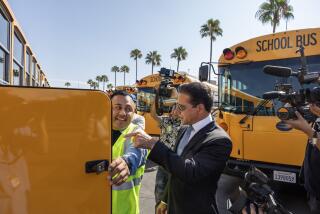Senator Would Build Schools Over, Under Crowded Urban Areas
- Share via
SACRAMENTO — The elementary school of the future in crowded California cities might be constructed over a street, beneath a public park or on top of a shopping center parking lot, under legislation proposed Monday.
Sen. Leroy Greene (D-Carmichael), a civil engineer and one of the Legislature’s experts on public education, said his unorthodox plan would provide a way to build new schools in fully developed areas without displacing residents.
Instead of clearing out neighborhoods to make room for traditional, single-level schools with broad expanses of campus, Greene said, he envisions multistory school buildings sitting atop bridge-like structures over existing streets.
He also foresees locating schools partially underground in parks “with tennis courts or other park amenities on the concrete roof of the school, which might be at ground level.”
Or, he said, perhaps a school could be constructed above the parking lot of a shopping center.
In each case, Greene noted, school districts would not have to bulldoze property in existing neighborhoods and would be spared the huge costs of buying already developed land in such cities as Los Angeles, Oakland and San Francisco.
Greene said funds saved by not buying land could, in turn, be invested in the school building, which he conceded would likely cost more to construct than a conventional structure. He estimated a school’s land cost savings at $10 million to $20 million, depending on the site.
Senate President Pro Tem David A. Roberti (D-Los Angeles), who endorsed the bill, said that the proposed expansion of Berendo Junior High School near the intersection of Olympic Boulevard and Vermont Avenue in Los Angeles calls for displacing 300 people from 68 homes.
“Tearing out homes in that kind of neighborhood is a heart-rending price to pay even for a needed school,” he told a press conference, noting that at least one dozen proposed schools in Los Angeles are “on hold” because of neighborhood concerns over the impact of the schools on traffic, noise, public safety and neighborhood stability.
Greene and Roberti said the unconventional approach to constructing “space-saver” elementary schools emerged as immigrants with large families have settled in high-density urban centers, and as unoccupied and unused land becomes both scarcer and more costly.
Roberti conceded that baseball fields and grassy playgrounds likely would not exist for children attending big city elementary schools in the future, but said this would be a necessary trade-off for living in urban centers.
Both lawmakers agreed that certain potential health hazards, such as automobile exhaust fumes or toxic waste threats, would emerge but that they would be dealt with. For example, schools over a busy street would be equipped with special air conditioning and windows would be sealed shut, they suggested.
Greene said his legislation would provide state funds for big-city school districts willing to try out the idea. As an incentive, he said he favored districts sponsoring a competition among architects to design such schools.
To encourage participation, he suggested that the winning architectural firm would receive a $100,000 bonus, with the second- and third-place finishers receiving $50,000 and $25,000, respectively.
More to Read
Get the L.A. Times Politics newsletter
Deeply reported insights into legislation, politics and policy from Sacramento, Washington and beyond. In your inbox twice per week.
You may occasionally receive promotional content from the Los Angeles Times.










